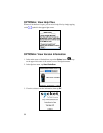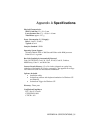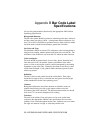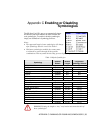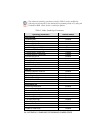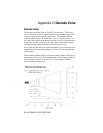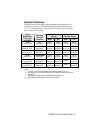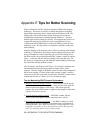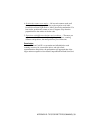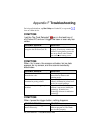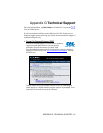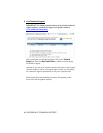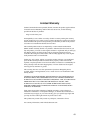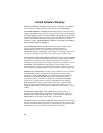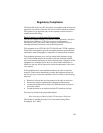
Appendix E Tips for Better Scanning
Socket’s SD Scan Card 3E is based on miniature CMOS linear imaging
technology. This device is basically a camera that captures rectangular
digital images measuring about 1 degree high and 40 degrees wide. The
imaging rate varies between about 20 and 40 images per second and
automatically compensates for ambient lighting conditions — the more
ambient light, the more images per second. It is inappropriate, however, to
compare this imaging rate to the rate of the sweeping beam of a laser
scanner because the CMOS image is affected by blurring, while the laser
technology is not. For this reason, it’s important to hold this scanner still
while scanning.
Adequate lighting of the target bar code is critical to scanning with imaging
technology. Unfortunately, providing auxiliary lighting increases the size,
energy consumption, control complexity and cost of the scanning device.
For these reasons, the red light from the SDSC scanner is simply an aiming
beam — it does not add any auxiliary lighting to the target bar code. For
this reason, it’s important to provide adequate ambient lighting to the target
bar code while scanning with this scanner.
Like all cameras, the SD Scan Card 3E has a "focal length" (minimum and
maximum distance from the target) where the image can be clearly
captured. The focal length of the SDSC scanner is rather small compared to
that of laser scanners. For best results while scanning “normal” sized bar
codes such as the UPC codes used on retail items, the SDSC scanner should
be held from about 4 to 7 inches (10 to 18 cm) from the target.
Tips for Maximizing SDSC Scanner Performance:
1. Minimize movement during scanning — The SD Scan Card 3E must be
held reasonably steady on the target for a short period of time while the
camera focuses and captures a clear image. The scanner typically
requires only several milliseconds to capture a clear image, no more than
a quarter to a half of a second.
2.
Provide adequate ambient lighting —The SDSC scanner, like any
camera, works much better when the target bar code is well-lit.
3.
Determine the optimum focal length — The SDSC scanner has a fairly
small focal length, so it is helpful to experiment until you find the best
scanning distance. Hint: When encountering scanning difficulties, most
people have a tendency to move the scanner too close to the target bar
code! Try moving it farther away for better results.
38 | APPENDIX E: TIPS FOR BETTER SCANNING



